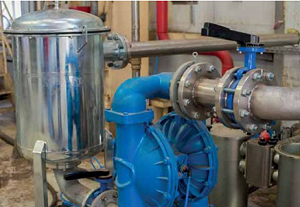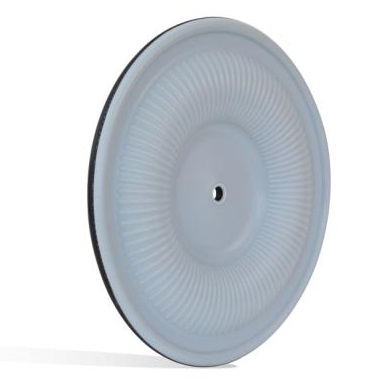These products are for industrial use only, not to be used in medical/food/pharma applications
When Mike Tyson famously said, "Everybody has a plan until they get punched in the mouth," it was a creative illustration of a timeless truth.
Difficult circumstances arise, and when they do, it is good practice to remain flexible and adaptable. You may even need to change your strategy altogether in order to succeed. Not all applications are created equal, and when the application is especially demanding, one, at times, must consider different solutions.

Such is the case regarding air operated double diaphragm (AODD) pumps. Typically, applications associated with this type of pump involve chemical compatibility 0.0 issues, abrasive element concerns, or a combination of the two.
Some examples include:
- Mining applications involving slurries of acids and solids
- Paint and coatings applications including chemical compatibility issues relating to solvents/additives and abrasion from pigments
- Ceramics
- Chemical processing
- Pulp and paper
- Similar applications using process media with abrasive solids
Transfer applications like these hold little room for error, and rely on the strength and consistency of AODD pumps. Used in a variety of contexts, these dependable, low-maintenance pumps offer a few distinct advantages across respective applications.
First and foremost, they are simple in composition and relatively inexpensive to operate. As AODD pumps run on compressed air, there are no flammable or combustible liquids to monitor while in use.
Likewise, they are mostly leak-free, and only suffer leakage when a diaphragm fails.
In light of this, it is imperative that plant managers keep a regular maintenance schedule while implementing high-quality diaphragms to extend the life of their pumps.
A second distinction that AODD pumps possess is that they have no internal seals or components that require lubrication or cooling.
This self-priming design ensures that the pump can run dry without risking damage, or worse, pump failure. Such functionality is a key component to both the life span and adaptability of AODD pumps altogether.
Lastly, AODD pumps have the ability to handle a variety of feeds, including large solids, abrasive materials, and viscous fluids, sludges, and slurries. Plus, their unique, gentle pumping action is optimal for transferring shear-sensitive liquids as well. Yet, despite their efficiency and versatility, AODD pumps do face some challenges worth mentioning.
Challenges of Abrasive Applications
To begin with, AODD pumps can be loud, prone to icing, and are generally limited to low-pressure applications. More importantly, abrasive applications cause significant physical wear on the diaphragms.
Normally, this occurs on the wet side of the diaphragm, at the outer diameter of either the housing or outer piston plate. Eventually, this wear compromises the diaphragm, leading to mechanical failure during dynanic movement.
In extreme cases, original equipment manufacturer (OEM) diaphragms can fail in a couple of days due to excessive abrasive wear.
Unfortunately, the outer housing obscures bath diaphragms from being visible during operation, so there is no easy way to monitor any wear indication along the way.
Abrasive wear is noticeable on a diaphragm - usually in a circular pattern around the outer piston plate - but it is commonly found far too late. In fact, the frustrating part is often finding there are no signs of underperformance until the diaphragm fails and flow stops completely.
When a diaphragm fails, it can be a challenging issue to address. To start, the sides of the housing must be removed, which is secured by a circular pattern of either bolts or C-clamps.
Then, the piston plates need to be removed and the media from the air side of the housing cleaned. Finally, the process must essentially be repeated in reverse to install the new diaphragms. As one can imagine, if a facility has a lot of these pumps - sometimes hundreds - the less they have to do this, the better.
PTFE vs. ePTFE
Polytetraftuoroethylene (PTFE) is one of the most chemically inert materials in the world, which proves to be a major advantage in terms of build quality.
Other than some fluorine compounds and alkali metals, nothing can chemically attack it. PTFE also has a higher temperature rating than rubber materials that are commonly used for diaphragms, so the
choice to produce PTFE diaphragms seems like a win-win, However, skived PTFE (what is used by OEM pump companies), has an Achilles heel of poor mechanical properties. It has high creep, uneven tensile strength, and high void content.
Due to the manufacturing process, the material can also be very inconsistent, meaning that one sample can vary in mechanical properties compared to another.
On the other hand, the expanded PTFE (ePTFE) that Garlock uses for its ONE-UP diaphragms has the same durable chemical makeup as skived PTFE, but without the mechanical flaws. More importantly, it removes the Achilles heel of traditional skived PTFE which results in high tensile strength, low creep, and low void content.
To illustrate the difference, in an MIT flex test (ASTM D2176), a piece of material is continuously bent at a 90 degree angle until failure - as a way to test 'flex life'. When the test was carried out with traditional skived PTFE, it failed at 4.1 million cycles.
The ePTFE went for 70 million cycles and still did not fail. Further, both the tensile strength and Mullins burst rating were three times higher for ePTFE than skived. Additionally, material creep for the ePTFE was about two to three times lower than skived PTFE.

ePTFE Diaphragms: A Longer-Lasting Solution
Consequently, ePTFE diaphragms last three times longer, on average, than OEM PTFE diaphragms. In extreme examples, these diaphragms have lasted 20 times longer.
In these instances, not only are plant managers buying significantly fewer parts, they are also spending a lot less time repairing pumps, which means a decrease in overall downtime. These ePTFE diaphragms are easier to install since they use a one-piece construction (the ePTFE facing is physically bonded to the elastomer), whereas OEM diaphragms are typically a two piece construction.
In the end, AODD pumps are low-cost, low-maintenance, and incredibly versatile devices to have as part of an application. However, they do have their limitations. It is crucial that the right investments are made in securing the highest-quality parts and components to ensure one gets optimal performance efficiency and longevity out of each pump. Not only will steps like these protect the bottom line, they also will provide peace of mind when tough circumstances arise.
The original article was written by Alex Eanniello, applications engineer for the diaphragm team at Garlock and can be found here.
For more information about diaphragms, or for application questions, contact Gallagher Fluid Seals. GFS is an authorized distributor for Garlock products.
